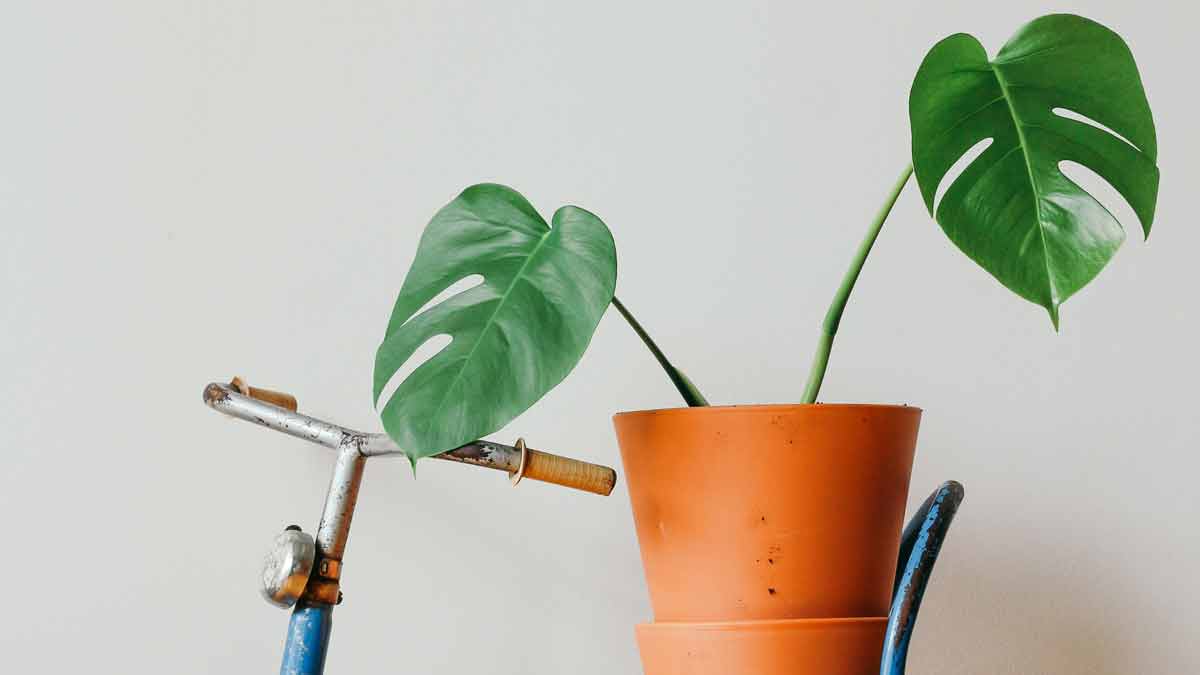Bottom watering Monstera plants can be beneficial as it allows the soil and roots to soak up water. Place the pot in a tray of water for 10-20 mins, making sure the soil is in contact with water. Water Monstera once a week, letting the soil dry partially before watering again.
Like the ever-popular Monstera deliciosa, houseplants bring vibrancy and life to any indoor space.
However, ensuring these plants thrive requires thoroughly understanding their watering needs.
In this complete guide on bottom watering Monstera plants, we’ll break down everything you need to know about this crucial technique that can make all the difference in your plant’s health and growth.
Learn how to master bottom watering for your indoor foliage friend by reading on!
Understanding Bottom Watering for Monstera Plants and Its Significance
Bottom watering is a process where the Monstera plant’s pot is placed in a container of water, allowing it to absorb moisture from the bottom up through its drainage holes, ensuring even hydration and promoting healthy root growth.
Benefits Of Watering From the Bottom
Bottom watering offers numerous benefits for Monstera plant care, making it a preferred choice among many houseplant enthusiasts.
Some advantages of bottom watering include the following:
- Even Moisture Distribution: Since water is absorbed through the drainage holes, the soil gets moistened evenly from the bottom up, ensuring all roots receive water.
- Water Conservation: Bottom watering allows plants to take up water more efficiently, reducing water wastage.
- Reduced Risk of Overwatering: As plants only absorb what they need, risks of overwatering and root rot are minimized.
- Less Disturbance to Plant Roots: There’s no need to poke the soil or move the plant during bottom watering, avoiding disruption to delicate root systems.
- Prevention of Fungal Growth: Keeping the leaves dry prevents humidity-loving fungal spores from multiplying and causing issues like mold or mildew.
- Minimized Soil Erosion: With no direct stream of water hitting the surface, soil compaction and erosion are less likely to occur.
- Encourages Root Growth: Bottom watering promotes healthy root growth by forcing roots to grow deeper as they seek out moisture in the lower layers of potting soil.
- Reduced Evaporation Losses: Since water is not applied directly on topsoil, there’s less chance for evaporation losses than overhead watering methods.
Adopting a bottom-watering approach for your plant can lead to healthier growth while conserving resources and preventing potential risks associated with other watering techniques.
Key Differences Between Bottom And Top Watering
Bottom watering and top watering are two common methods of plant hydration.
One key difference between the two is the way the plant’s roots absorb water.
With bottom watering, the water is absorbed from under the soil through drainage holes, while with top watering, it is poured onto the surface of the soil.
Another difference lies in how often one needs to water the plants.
Bottom watering allows for a more consistent moisture level.
It can be done less frequently than top watering, which may require more frequent but lighter water applications to prevent run-off.
When choosing between bottom and top watering for your Monstera plants, remember that each method has its benefits and drawbacks.
While bottom watering offers better control over moisture levels and reduces the risk of overwatering or root rot, it requires more preparation time compared to top-watering techniques.
On the other hand, with top-watering techniques like mist spraying or overhead irrigation systems such as drip lines, you can quickly hydrate your Monstera plants without much fuss.
However, you have less control over where that liquid goes inside or around your potted plant’s root system.
Ultimately, deciding which technique works best for you depends on what kind of environment you want to provide for your lovely houseplants!
When To Use Bottom Watering for Monstera Plants
Bottom watering is an excellent option for Monstera plants when the soil feels dry.
This method of watering allows the plant roots to absorb water from below, ensuring even moisture distribution throughout the soil.
It is also beneficial if you have a busy schedule and want to leave your plants unattended for a few days without worrying about dehydration.
It’s essential not to overwater or underwater your Monstera plants, as both can lead to root rot and other problems.
Depending on factors such as humidity levels, pot size, and light exposure, most Monsteras need bottom watering once every one or two weeks.
Be sure to soak the plant in water for 15-20 minutes before draining excess water and returning it to its saucer.
How Often To Water Monsteras From the Bottom
Watering your Monstera regularly is essential to ensure proper growth and health.
When it comes to bottom watering, this should be done every 1-2 weeks, depending on your plant’s specific needs.
You can determine if your Monstera needs watering by checking the soil moisture level with a finger or moisture meter.
Additionally, factors such as room temperature, humidity levels, and pot size can affect how often you need to bottom water your plant.
In hotter or drier conditions, you may need to water more frequently.
Observing your plant closely and adjusting your watering schedule for optimal results is best.
Remember that overwatering can lead to root rot and other issues. So, it’s better to be cautious when determining how often to bottom water your plant.
Key Considerations Before Initiating the Watering Process
Before bottom watering your Monstera plant, it is essential to prepare the water correctly.
Tap water contains chemicals such as chlorine that can harm your plants; therefore, it is recommended to use filtered or chemical-free water for the best results.
Using room temperature water also helps prevent shock to the plant’s root system.
Another crucial factor when preparing the water for bottom watering is ensuring enough moisture retention in the soil.
The soil should have a good mixture of organic material and sand or perlite to allow proper drainage while retaining the moisture necessary for healthy root growth.
Adding balanced liquid fertilizer can also add nutrients beneficial for your Monstera plant’s overall health and growth.
Overall, using appropriate techniques like using filtered or chemical-free room temperature water with sufficient nutrient-rich soil mixtures, you can efficiently prepare the right conditions before bottom watering your Monsteras – promoting thriving houseplants in return.
Step-by-Step Guide to Effectively Bottom Water Monstera Plants
To bottom water Monstera plants, choose a container with drainage holes and fill it with filtered or chemical-free water.
Next, gently place the potted plant into the water and allow it to soak for 15-20 minutes until the soil is moistened from the bottom up.
Then, carefully remove the pot from the water and let any excess drain out before returning it to its saucer.
Repeat this process once a week or as needed based on moisture levels in the soil.
1. Choosing The Appropriate Container
When choosing a container for bottom watering Monstera plants, it is important to consider the size and drainage capabilities of the pot.
Here are some tips for choosing the appropriate container:
- Size: Choose a large pot to accommodate your plant’s root system, allowing room for growth. The pot size should be proportional to the size of the plant.
- Drainage Holes: Ensure the container has proper drainage holes at the bottom to allow water to flow out easily. Without drainage holes, excess water can accumulate in the soil and lead to root rot.
- Material: Clay or terracotta pots are excellent choices as they allow air circulation, which helps prevent overwatering and promote healthy root growth. However, plastic containers can also work well and are lightweight and easy to move around.
- Saucer: Choose a saucer larger than your chosen container’s base to catch any excess water that may escape during watering.
- Depth: The depth of the container should be suitable for your plant’s root system and height. A shallow pot may dry out too quickly, while a very deep pot could retain too much moisture.
Following these guidelines when selecting a container for bottom watering will ensure that your Monstera plant has a healthy growing environment with adequate water absorption and good drainage capabilities.
2. Preparing The Soil
Preparing the soil for bottom watering is a crucial step in ensuring the health and growth of Monstera plants.
It is important to choose high-quality potting soil that provides good drainage and nutrition for the plant.
The soil should be moistened before being placed in the container, but not soaking wet or too dry.
To prepare the soil, mix equal parts of peat moss, perlite, and vermiculite to create a well-balanced medium.
This mixture will provide excellent drainage while retaining moisture, essential for healthy Monstera growth.
Additionally, adding organic matter such as compost or worm castings can help improve soil quality and provide valuable nutrients to feed your plant over time.
3. Placing The Plant In The Water
When it’s time to bottom water your Monstera plant, follow these steps to place the plant in the water properly:
- Choose a container with drainage holes, such as a sink or bathtub.
- Fill the container with filtered or chemical-free water, ensuring that the water level is just below the soil line of the plant.
- Gently lower your potted plant into the water, making sure that all sides of the pot are submerged.
- Allow the plant to soak up water from the bottom up for 15-20 minutes.
- After soaking, remove your plant from the container and allow it to drain off excess water completely in its dry saucer.
These simple steps and a proper watering schedule will ensure optimal care for your Monstera plants and promote healthy growth.
4. Soaking Time
When bottom watering plants, knowing the appropriate soaking time is essential.
The plant should be left in the water for about 15-20 minutes, depending on its size and moisture needs.
It’s important not to leave the pot in water for too long as this can lead to overwatering and, eventually, root rot.
During the soaking time, it’s also vital to keep an eye on the plant’s amount of absorption.
If there are still bubbles coming out of the drainage holes after 15-20 minutes, then you can continue with more soaking time until no more bubbles are present.
Doing so ensures that your Monstera is properly hydrated and healthy!
5. Draining Excess Water
When bottom watering plants, excess water should be drained to prevent the soil from becoming too moist.
Here are some tips for draining excess water:
- After soaking the plant in water for 15-20 minutes, remove it from the container.
- Allow the excess water to drain from the pot’s drainage holes and into its saucer.
- Tilt the pot slightly to help remove any additional water trapped in the soil.
- Once the excess water has drained away, empty the saucer to avoid moisture retention.
- Return the plant to its original location, ensuring it does not sit in standing water.
Draining excess water is crucial for preventing overwatering and root rot, which can harm plants’ health and growth.
Monitoring your plant’s moisture levels regularly and adjusting your watering schedule to maintain a healthy balance between hydration and drainage is essential.
Avoiding Common Mistakes When Watering Monstera Plants
To avoid common mistakes when bottom watering Monstera plants, it is important:
- Not to overwater.
- Use room temperature or filtered water without chemicals like chlorine.
- Ensure proper drainage in the container.
- Avoid watering on a set schedule.
- Pay attention to the plant’s moisture levels and health.
1. Overwatering
Overwatering is a common mistake that can harm Monstera plants.
Here are some tips on how to avoid overwatering Monstera plants:
- Check the soil moisture level regularly with a moisture meter or by sticking your finger into the soil.
- Only water the plant when the top one to two inches of soil feels dry.
- Reduce watering frequency during the cooler winter months when plants require less water.
- Do not leave the pot sitting in standing water for an extended period.
- Provide adequate drainage by using soil with good drainage and ensuring sufficient drainage holes in the pot.
- Remove any excess water from saucers underneath pots after watering to prevent root rot.
- Monitor the plant’s health carefully, including checking for yellow or wilted leaves, which may indicate overwatering.
By following these tips and being mindful of how much and how often to water your Monstera plant, you can avoid overwatering and ensure its continued health and growth.
2. Using Cold Water
Using cold water for watering Monstera plants should be avoided as it can cause stress to the plant.
Cold water can shock the roots and disrupt their ability to absorb nutrients, leading to stunted growth and wilting leaves.
Using room temperature or slightly warm water when watering plants is best.
In addition, using chlorine-heavy tap water can also harm plants.
Chlorine can burn the tender roots of Monsteras, causing them to wither and die.
To avoid this, using filtered or chemical-free water when bottom watering your Monstera plant is recommended.
Overall, bottom watering is a great way to keep your Monstera plant healthy and hydrated.
Just remember to use proper water temperature and quality for optimal results.
3. Lack Of Proper Drainage
Improper drainage can affect the health of Monstera plants, leading to root rot and other diseases.
Here are some things to keep in mind when considering proper drainage:
- Choose a container with drainage holes: A lack of drainage holes can cause water to accumulate at the bottom of the pot, which can put stress on the roots and may lead to overwatering.
- Use well-draining soil: Soil that retains too much water can cause root rot. Ensure the soil has enough perlite, sand, or gravel to increase drainage and prevent moisture retention.
- Monitor water levels: Always check how much water is left in the saucer or tray after watering, and empty it if there is an excess amount.
- Water properly: Overwatering or underwatering can both contribute to improper drainage. Follow a proper watering schedule for plants based on their size and location.
- Check for signs of stress: If leaves start yellowing, wilting, or showing brown spots, it may indicate inadequate drainage or overwatering.
Taking these steps toward proper drainage can help ensure your Monsteras stay healthy and vibrant for years.
4. Watering On A Set Schedule
Watering your Monstera plant on a set schedule may seem like an excellent way to ensure it’s getting the right amount of water, but it can be counterproductive.
Monstera plants don’t have specific watering needs, and their requirements vary depending on factors such as humidity levels, temperature, and soil moisture.
Following a strict watering regimen can lead to over or under-watering the plant.
It is best to know when your plant needs water by checking its soil regularly.
Plants in a well-draining potting mix often take longer for water absorption than those in dense clay soils.
The top inch should feel somewhat dry before you start watering again, allowing you to monitor the moisture level without risking any damage from excessive or inadequate watering routines.
Remember that different conditions will affect how fast moisture evaporates from your Monstera’s substrate, requiring more or less frequent hydration periods accordingly.
5. Monitoring The Plant’s Health
Keeping a close eye on the health of your Monstera plant is crucial to its longevity and growth.
Here are some tips to help you monitor your plant’s health:
- Check the leaves regularly for any signs of discoloration, wilting, or drooping, which could indicate underwatering or overwatering.
- Monitor the soil moisture levels by sticking your finger about an inch deep into the soil. If it feels dry, it’s time to water your plant.
- Look out for pests such as spider mites or mealybugs that may damage your plant.
- Watch for changes in the plant’s growth rate or appearance, such as stunted growth or yellowing leaves.
- Keep track of how often you water and fertilize your Monstera plant and adjust if needed.
By regularly monitoring the health of your Monstera plant, you can catch any issues early on and take steps to correct them before they become major problems.
Final Thoughts
Bottom watering is a fantastic way to keep your Monsteras healthy and happy.
Following the steps outlined in this guide ensures that your plant receives adequate hydration without risking overwatering or root rot.
Always choose a container with drainage holes and use chemical-free, filtered water.
Remember to monitor your plant’s health regularly and adjust watering frequency accordingly.
With proper care, your Monstera plant will thrive and grow into a lush jungle beauty that will bring joy to any space!







